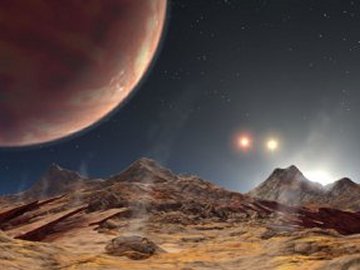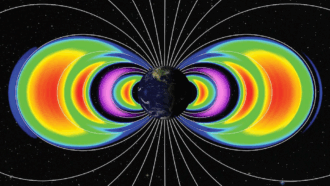World of Three Suns
A planet in the Milky Way tightly orbits the main star of a stellar trio.
Share this:
- Share via email (Opens in new window) Email
- Click to share on Facebook (Opens in new window) Facebook
- Click to share on X (Opens in new window) X
- Click to share on Pinterest (Opens in new window) Pinterest
- Click to share on Reddit (Opens in new window) Reddit
- Share to Google Classroom (Opens in new window) Google Classroom
- Click to print (Opens in new window) Print
By Emily Sohn
Astronomers have discovered a planet in the Milky Way galaxy that has three suns.
It’s weird enough trying to imagine three suns in the sky at once. Scientists are having a hard time explaining how such a planet could exist in the first place.
 |
|
In this illustration, an artist imagines what the view might be like if a newly discovered planet in a system containing three stars happened to have a moon. From the moon, the planet and two stars are visible in the sky, and a third star is just setting behind some mountains. |
| R. Hurt/Caltech |
Astronomers from the California Institute of Technology in Pasadena recently spotted the planet, which is similar in size and composition to Jupiter. The new object orbits one star that lies close to two other stars. Together, the sun trio is called HD 188753.
There are lots of star groups in the galaxy, but scientists have long thought it impossible for planets to form near groups in which stars are bunched very close together. Huge planets, such as Jupiter (which is about 300 times heavier than Earth), normally form out of swirling disks of gas, dust, and ice. However, the heat and strong gravity of three nearby suns would probably prevent such a process from occurring.
The Caltech researchers initially hypothesized that the newly discovered planet formed as much as three times farther away from its sun as Earth is from our sun. This theory runs into problems, however. The stars in HD 188753 lie so close together (about as far apart as Saturn and our sun) that their gravity wouldn’t allow room for the planet.
Now, scientists are looking for other ways to explain this odd phenomenon. As they do, astronomers are getting ready for a new search. There might be many more planets out there near pairs, trios, or even larger star systems long thought to be without planets.—E. Sohn
Going Deeper:
Cowen, Ron. 2005. Triple play: A planet with three suns. Science News 168(July 16):38. Available at http://www.sciencenews.org/articles/20050716/fob8.asp .
Additional information about the discovery of a planet with three suns can be found at planetquest.jpl.nasa.gov/news/7_13_images.html (NASA) and pr.caltech.edu/media/Press_Releases/PR12716.html (Caltech).
For a science-fair project about three-star systems, see http://www.sciencenewsforkids.org/articles/20041013/ScienceFairZone.asp .
Sohn, Emily. 2005. Cousin Earth. Science News for Kids (June 29). Available at http://www.sciencenewsforkids.org/articles/20050629/Note2.asp .






